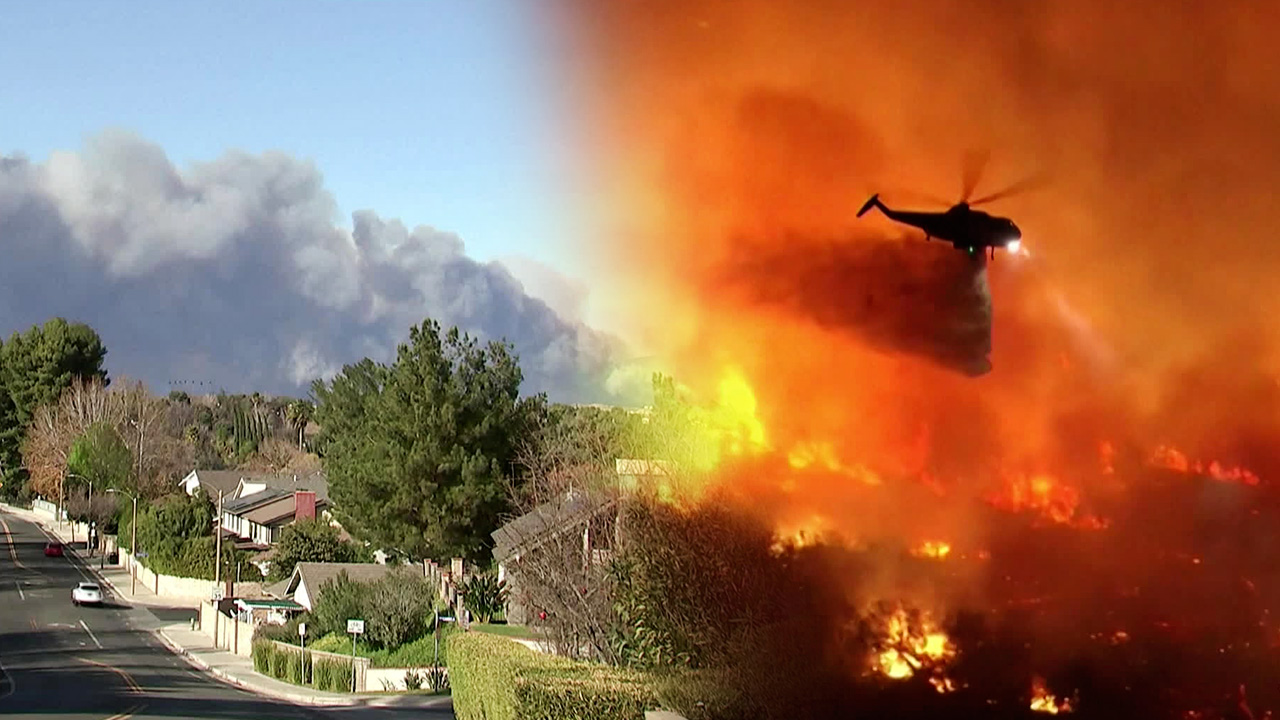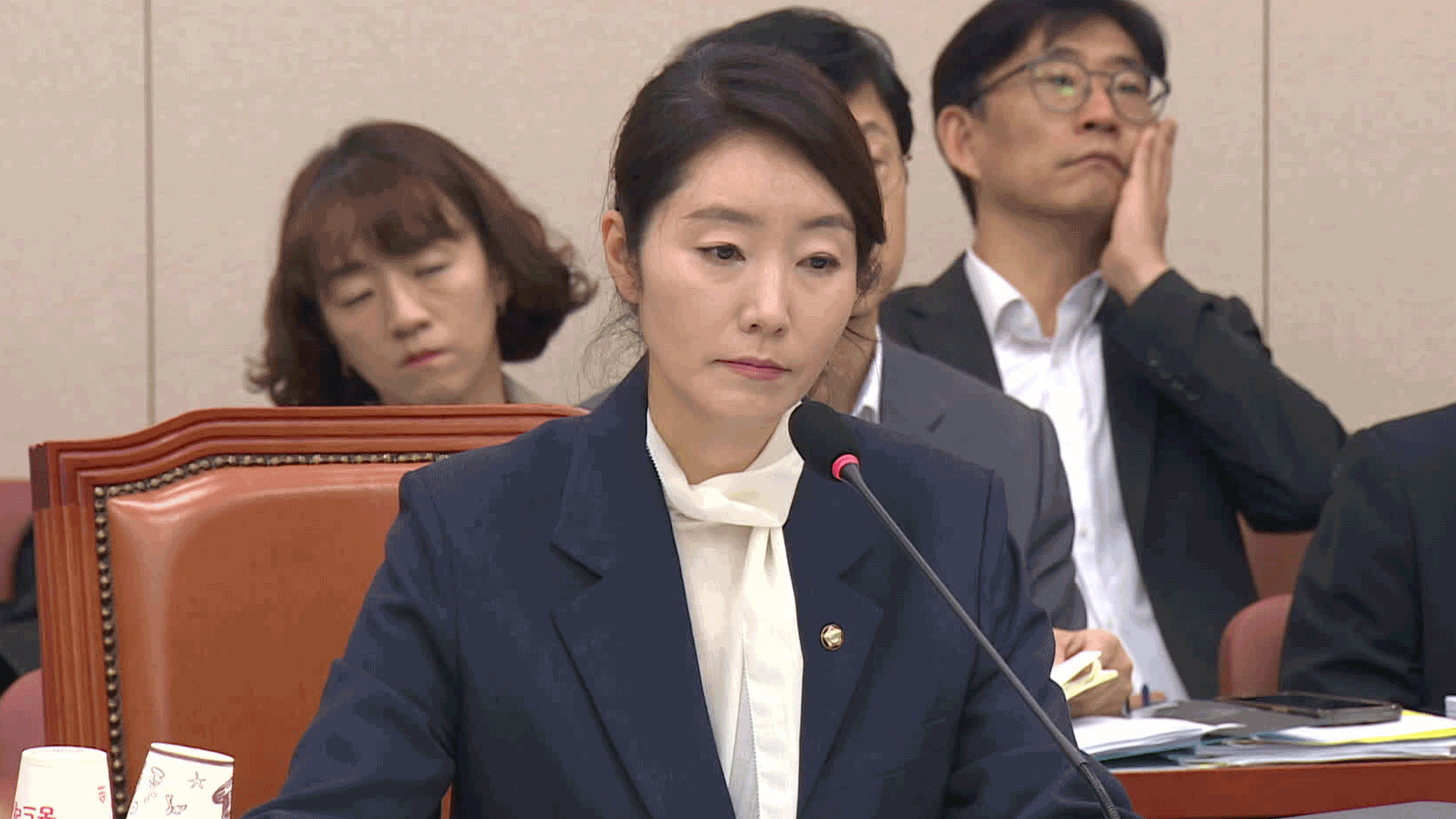[Anchor]
Last month, the worst wildfire in 40 years occurred in Los Angeles, U.S..
The simultaneous occurrence of such large wildfires during a non-dry season is attributed to climate change.
Our country, which experiences frequent wildfires every year, cannot be at ease either.
Shin Bang-sil reports.
[Report]
Red flames engulf the parched land, and columns of gray smoke rise into the sky.
Amid ongoing drought, the combination of dry winds descending from the mountains has led to the worst simultaneous wildfire damage in California in 40 years.
The background of these large wildfires occurring despite it not being a dry season is climate change.
Recently, domestic researchers predicted that the droughts occurring in the western United States during winter are caused by global warming and will intensify in the future.
As the equatorial western Pacific warms, convection phenomena increase, leading to the development of strong high pressure in the western United States.
[Yoon Jin-ho/Professor, Department of Environmental Energy Engineering, Gwangju Institute of Science and Technology (GIST): "Due to the climate crisis, as the Earth warms, the pressure system continues to strengthen... This developed high pressure becomes a very favorable factor for creating dry conditions in the western region of the (United States)."]
In our country, where large wildfires occur periodically, the risk period for wildfires on the Korean Peninsula is lengthening due to climate change, and weather conditions such as strong winds are exacerbating the damage.
[Jung Ji-hoon/Professor, Department of Environmental Convergence Engineering, Sejong University: "It is a dry season from autumn, winter, to spring, and during that time, temperatures rise significantly, leading to a lot of evaporation from the surface. When spring comes, with strong winds, wildfires occur frequently..."]
If carbon emissions are not reduced, the risk of wildfires is expected to increase by 106% by the middle of this century and by 158% by the end of the century.
Warnings are being issued that if we cannot return the increasingly warming climate to its original state, disasters that we have never experienced before will become a part of our daily lives in the future.
This is Shin Bang-sil from KBS News.
Last month, the worst wildfire in 40 years occurred in Los Angeles, U.S..
The simultaneous occurrence of such large wildfires during a non-dry season is attributed to climate change.
Our country, which experiences frequent wildfires every year, cannot be at ease either.
Shin Bang-sil reports.
[Report]
Red flames engulf the parched land, and columns of gray smoke rise into the sky.
Amid ongoing drought, the combination of dry winds descending from the mountains has led to the worst simultaneous wildfire damage in California in 40 years.
The background of these large wildfires occurring despite it not being a dry season is climate change.
Recently, domestic researchers predicted that the droughts occurring in the western United States during winter are caused by global warming and will intensify in the future.
As the equatorial western Pacific warms, convection phenomena increase, leading to the development of strong high pressure in the western United States.
[Yoon Jin-ho/Professor, Department of Environmental Energy Engineering, Gwangju Institute of Science and Technology (GIST): "Due to the climate crisis, as the Earth warms, the pressure system continues to strengthen... This developed high pressure becomes a very favorable factor for creating dry conditions in the western region of the (United States)."]
In our country, where large wildfires occur periodically, the risk period for wildfires on the Korean Peninsula is lengthening due to climate change, and weather conditions such as strong winds are exacerbating the damage.
[Jung Ji-hoon/Professor, Department of Environmental Convergence Engineering, Sejong University: "It is a dry season from autumn, winter, to spring, and during that time, temperatures rise significantly, leading to a lot of evaporation from the surface. When spring comes, with strong winds, wildfires occur frequently..."]
If carbon emissions are not reduced, the risk of wildfires is expected to increase by 106% by the middle of this century and by 158% by the end of the century.
Warnings are being issued that if we cannot return the increasingly warming climate to its original state, disasters that we have never experienced before will become a part of our daily lives in the future.
This is Shin Bang-sil from KBS News.
■ 제보하기
▷ 카카오톡 : 'KBS제보' 검색, 채널 추가
▷ 전화 : 02-781-1234, 4444
▷ 이메일 : kbs1234@kbs.co.kr
▷ 유튜브, 네이버, 카카오에서도 KBS뉴스를 구독해주세요!
- Wildfire warnings for Korea
-
- 입력 2025-02-03 00:06:23

[Anchor]
Last month, the worst wildfire in 40 years occurred in Los Angeles, U.S..
The simultaneous occurrence of such large wildfires during a non-dry season is attributed to climate change.
Our country, which experiences frequent wildfires every year, cannot be at ease either.
Shin Bang-sil reports.
[Report]
Red flames engulf the parched land, and columns of gray smoke rise into the sky.
Amid ongoing drought, the combination of dry winds descending from the mountains has led to the worst simultaneous wildfire damage in California in 40 years.
The background of these large wildfires occurring despite it not being a dry season is climate change.
Recently, domestic researchers predicted that the droughts occurring in the western United States during winter are caused by global warming and will intensify in the future.
As the equatorial western Pacific warms, convection phenomena increase, leading to the development of strong high pressure in the western United States.
[Yoon Jin-ho/Professor, Department of Environmental Energy Engineering, Gwangju Institute of Science and Technology (GIST): "Due to the climate crisis, as the Earth warms, the pressure system continues to strengthen... This developed high pressure becomes a very favorable factor for creating dry conditions in the western region of the (United States)."]
In our country, where large wildfires occur periodically, the risk period for wildfires on the Korean Peninsula is lengthening due to climate change, and weather conditions such as strong winds are exacerbating the damage.
[Jung Ji-hoon/Professor, Department of Environmental Convergence Engineering, Sejong University: "It is a dry season from autumn, winter, to spring, and during that time, temperatures rise significantly, leading to a lot of evaporation from the surface. When spring comes, with strong winds, wildfires occur frequently..."]
If carbon emissions are not reduced, the risk of wildfires is expected to increase by 106% by the middle of this century and by 158% by the end of the century.
Warnings are being issued that if we cannot return the increasingly warming climate to its original state, disasters that we have never experienced before will become a part of our daily lives in the future.
This is Shin Bang-sil from KBS News.
Last month, the worst wildfire in 40 years occurred in Los Angeles, U.S..
The simultaneous occurrence of such large wildfires during a non-dry season is attributed to climate change.
Our country, which experiences frequent wildfires every year, cannot be at ease either.
Shin Bang-sil reports.
[Report]
Red flames engulf the parched land, and columns of gray smoke rise into the sky.
Amid ongoing drought, the combination of dry winds descending from the mountains has led to the worst simultaneous wildfire damage in California in 40 years.
The background of these large wildfires occurring despite it not being a dry season is climate change.
Recently, domestic researchers predicted that the droughts occurring in the western United States during winter are caused by global warming and will intensify in the future.
As the equatorial western Pacific warms, convection phenomena increase, leading to the development of strong high pressure in the western United States.
[Yoon Jin-ho/Professor, Department of Environmental Energy Engineering, Gwangju Institute of Science and Technology (GIST): "Due to the climate crisis, as the Earth warms, the pressure system continues to strengthen... This developed high pressure becomes a very favorable factor for creating dry conditions in the western region of the (United States)."]
In our country, where large wildfires occur periodically, the risk period for wildfires on the Korean Peninsula is lengthening due to climate change, and weather conditions such as strong winds are exacerbating the damage.
[Jung Ji-hoon/Professor, Department of Environmental Convergence Engineering, Sejong University: "It is a dry season from autumn, winter, to spring, and during that time, temperatures rise significantly, leading to a lot of evaporation from the surface. When spring comes, with strong winds, wildfires occur frequently..."]
If carbon emissions are not reduced, the risk of wildfires is expected to increase by 106% by the middle of this century and by 158% by the end of the century.
Warnings are being issued that if we cannot return the increasingly warming climate to its original state, disasters that we have never experienced before will become a part of our daily lives in the future.
This is Shin Bang-sil from KBS News.
-
-

신방실 기자 weezer@kbs.co.kr
신방실 기자의 기사 모음
-
이 기사가 좋으셨다면
-
좋아요
0
-
응원해요
0
-
후속 원해요
0










![[단독] “윤석열·김용현 등 공모해 군사상 이익 해쳐”<br>…외환죄 대신 일반이적죄 적용](/data/layer/904/2025/07/20250714_3VTJV3.jpg)




이 기사에 대한 의견을 남겨주세요.